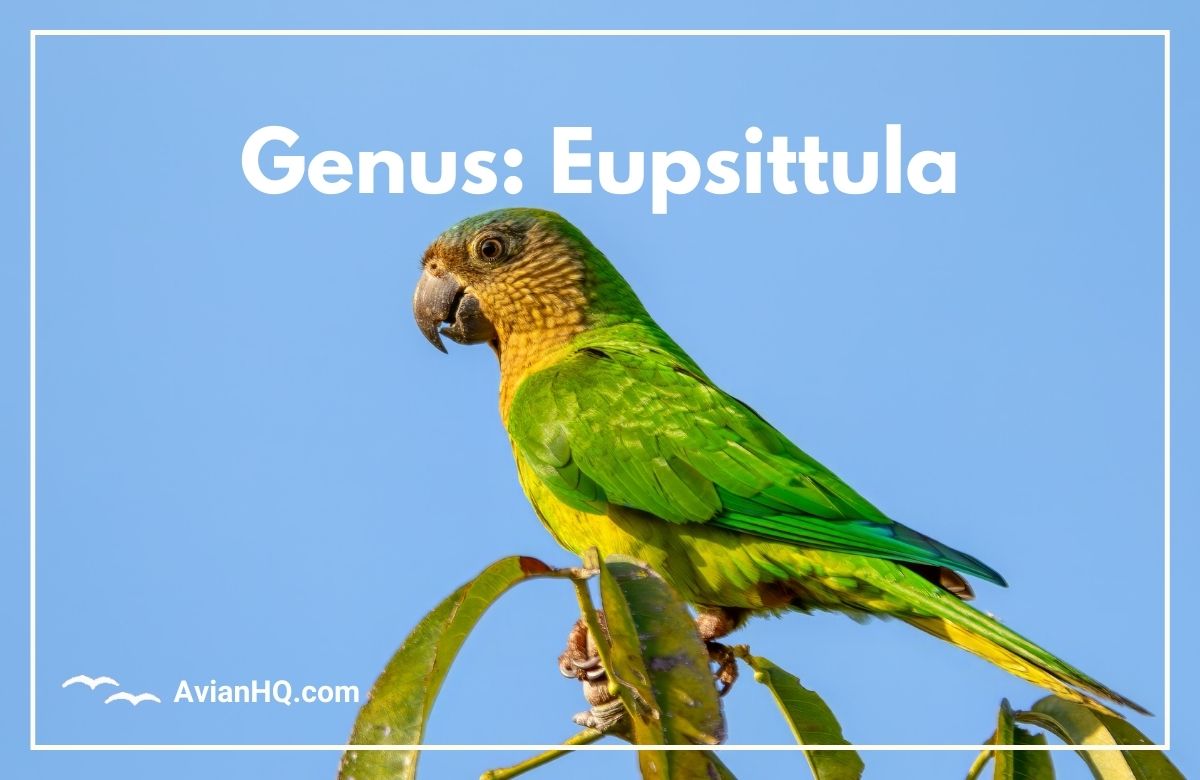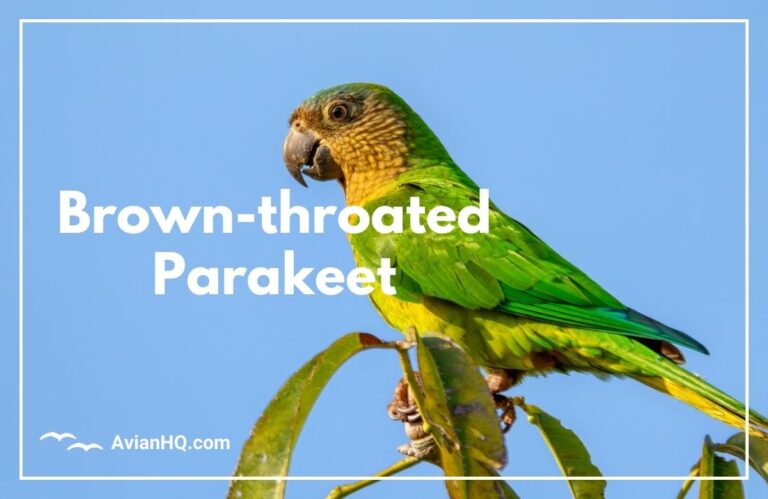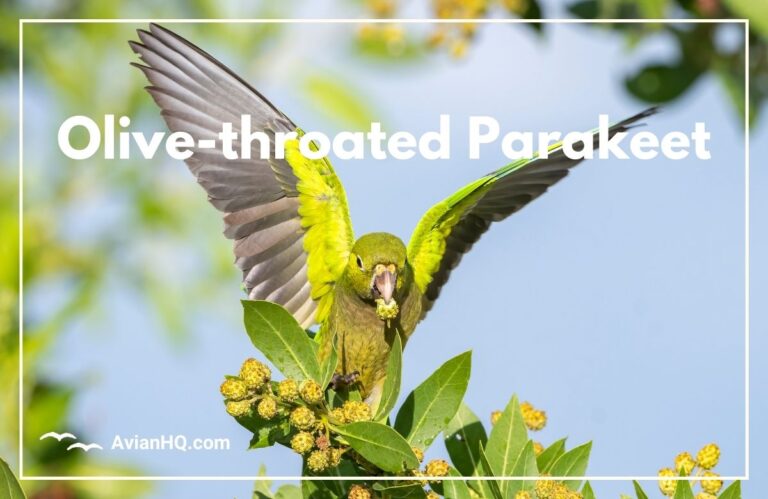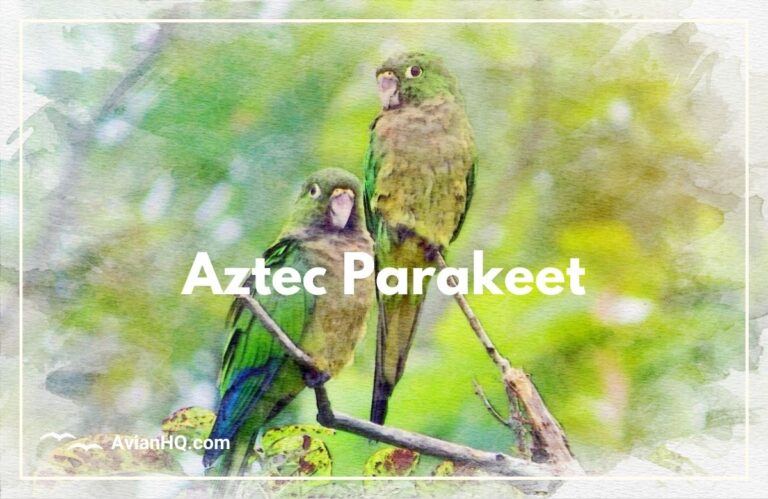Genus: Eupsittula
Have you ever seen a small, bright green parrot with a splash of color on its forehead or chest flying through the forests of Mexico or northern South America? If so, you may have spotted one of the six lively parakeet species that belong to the genus Eupsittula.
These birds are part of the larger parrot family, scientifically known as Psittacidae. The Eupsittula parakeets are mid-sized parrots measuring between 9 to 14 inches long. Their primarily green plumage helps them blend into the tropical and subtropical forests they call home.
“The genus Eupsittula contains a rainbow of small, energetic parakeets that add a splash of color and sound to the landscapes they inhabit.”
You can tell the difference between each Eupsittula species by subtle variations in size, shade of green, and the colorful markings on their heads and throats. For example:
- The Aztec Parakeet has a yellow-orange forehead and breast.
- The Peach-fronted Parakeet lives up to its name with its peach and orange colored brow.
- The Orange-fronted Parakeet also has, you guessed it, a vibrant orange patch above its beak.
Eupsittula parakeets lead active, social lives zipping through trees in large, noisy flocks. Their high-pitched squawks and chattering calls reverberate through the forest as they search for food or Claim nesting spots.
Let’s explore what makes this genus so colorful, vocal, and full of life!
Species Spotlights
The six species in the Eupsittula genus have distinct traits and behaviors that help them thrive in their native ranges across Mexico, Central and South America. Let’s highlight what makes each one unique:
Aztec Parakeet (Eupsittula astec)
The vibrant green Aztec Parakeet grows to about 11 inches (28 cm) long. As mentioned before, it has bright yellow and orange markings on its forehead and breast. These small parrots live solely in central Mexico.
You’ll find them nesting high in tree cavities and feeding on seeds, fruits, buds, and insects. Deforestation and trapping for the pet trade threaten the wild Aztec Parakeet population of less than 10,000 remaining birds.
Peach-fronted Parakeet (Eupsittula aurea)
True to its name, this species sports peach and orange feathers on its brow. It reaches 12 inches (30 cm) long. The Peach-fronted Parakeet makes its home in forests from Mexico down into Costa Rica.
It prefers to nest in tree hollows lined with soft wood dust. Flocks chatter loudly while foraging for berries, seeds, nuts, and flowers. Habitat loss due to agriculture threatens some populations.
Cactus Parakeet (Eupsittula cactorum)
As you may have guessed, this small parakeet has specially adapted to thrive in dry desert climates. It even nests in cactus cavities! At just 9 inches (23 cm) long, it is the smallest Eupsittula species.
Cactus Parakeets live in western South America in areas with scattered cacti and trees. Their range spans from southern Peru down through northern Chile. These resourceful birds tap cactus fruits and flowers for food. With extremely limited habitat, their numbers are estimated at less than 1,000 birds.
Orange-fronted Parakeet (Eupsittula canicularis)
A bright orange patch on its forehead gives this species its name. It grows to about 13 inches (33 cm) in length. The Orange-fronted Parakeet makes its home along the Pacific regions of Mexico and parts of Central America.
You’ll find it nesting in tree cavities and skimming over both forest and cultivated areas. It forages for fruit crops as well as wild seeds, berries, and insects. As forests are converted for agriculture, this species must adapt to the changing habitat.
Olive-throated Parakeet (Eupsittula nana)
The small Olive-throated Parakeet lives up to its name with olive-yellow feathers on its throat. It reaches just under 12 inches (30 cm) long. This species sticks to tropical forests on the Caribbean slopes of Costa Rica and Panama.
Flocks chatter noisily while hopping along branches searching for fruit. Nesting occurs in tree cavities. Continued habitat loss coupled with capture for the caged bird trade threatens populations already numbering under 10,000 birds.
Brown-throated Parakeet (Eupsittula pertinax)
As the name indicates, this parakeet has rich brown plumage on its throat and upper chest. It grows a bit larger than other Eupsittula species, up to 14 inches (36 cm) long. The Brown-throated Parakeet makes its home across northern South America in Venezuela, Colombia, Ecuador and Peru.
You can spot flocks harvesting fruit crops as they forage through forests and agricultural areas. They prefer to nest high in palms. Deforestation remains the main threat, while trade in wild-caught birds also occurs to a small degree.
Behavior and Intelligence
Eupsittula parakeets are highly social birds that form large, boisterous flocks. You’ll often hear them before you see them due to their constant loud squawking and chattering. Flocks may include just one species or mix multiple types together.
These agile flyers zip through trees while foraging. When taking off in flight, their wings make a distinct rattling sound. Eupsittula parakeets use strong beaks and claws to climb along branches and extract seeds and fruit.
Some interesting behaviors include:
- Complex social interactions – They form monogamous breeding pairs and defend nest sites from other members of the flock. Each mated pair coordinates parenting duties.
- Communal roosting – Large flocks return to traditional roost sites in trees at night, likely for safety from predators.
- Food sharing – Eupsittula parakeets sometimes pass tasty morsels of food to flock members at communal roosting spots. This may help coordinate flock movements to plentiful feeding areas.
- Mimicry – They imitate a wide range of calls and sounds in their environment, even human speech. Some have vocabulary of up to 40 words!
Researchers rank parakeets close to crows and ravens in levels of intelligence due to their advanced social interactions and adaptability. Like other parrots, Eupsittula parakeets thrive in complex environments where they can put their intelligence to work foraging, communicating, and solving problems. The diversity of ecosystems and habitats they inhabit speaks to their behavioral flexibility.
Cultural Significance
The bright colors, loud voices, intelligence, and social nature of Eupsittula parakeets have made them more than just forest-dwelling birds to indigenous peoples across the Americas.
For example, the Aztec and Mayan civilizations held the parakeet as a sacred symbol. Images of parakeets decorated religious temples. The birds appear in folk tales as messengers of the gods.
Many Native American tribes also integrated parakeet feathers into ceremonial costumes and headdresses. Chiefs and warriors wore the feathers as status symbols, believing they brought attributes like intelligence and bravery.
“Parakeet feathers held deep symbolic meaning for indigenous cultures across Mexico and Central America.”
Today, Eupsittula parakeets remain popular household pets. The Aztec Parakeet, in particular, is prized in the cage bird trade for its stunning coloration. Their ability to mimic speech endears them to many owners.
Of course, demand for wild-caught birds contributes to some Eupsittula species’ threatened status. However, several parakeet species adapt well to life as pets when bred in captivity instead of being taken from fragile wild populations.
Eupsittula parakeets earn spots as national birds in parts of their native ranges. For example, the Olive-throated Parakeet represents Costa Rica and the Cactus Parakeet makes appearances on stamps and currency in Peru and Chile. Bright artwork of the parakeets can be found decorating homes and handicraft markets throughout Central and South America.
Threats and Conservation
Although small parakeet species, Eupsittula parakeets face substantial habitat threats driving several populations close to endangered status.
The primary threat across the genus’ range comes from deforestation. Logging, land clearing for agriculture, and development pressure shrink the tropical forests these birds rely on for nesting and feeding. For example, over 50% of lowland forest habitat has been converted to farmland in regions of Costa Rica and Panama.
Parakeets must compete for scarce nesting cavities and food sources in fragmented forest patches. Stripped landscapes lack the large hardwood trees needed for nesting cavity formation over time.
Additional threats include:
- Pet Trade – Smugglers trap wild parakeets to sell into the lucrative exotic bird market, despite restrictions in some countries. Each bird removed from the wild directly impacts fragile breeding populations. Over 7,500 Orange-fronted Parakeets were exported from Nicaragua and Honduras in recent decades according to research.
- Predators & Competition – Nest-robbing predators like toucans and conflict with invasive bird species are increasing pressures on some Eupsittula populations.
Conservation groups now recognize Eupsittula habitat protection as critical to the future survival of Central and South America’s endangered forests. Parakeet-focused reintroduction and nest box programs help stabilize populations in protected reserves in Costa Rica, Panama, Peru and Mexico.
Increased law enforcement helps curb illegal poaching for the pet trade. Several Eupsittula parakeets now show stable or increasing populations thanks to intensive conservation efforts across their ranges.
Conclusion
The genus Eupsittula contains a diverse group of small, vibrantly colored parakeets. What they lack in size, they make up for in energy and enthusiasm. Their loud voices and acrobatic flights bring life to the canopies of tropical forests.
These intelligent, adaptable birds play important roles distributing seeds, pollinating plants, and even controlling insect populations in their native habitats. Tragically, several Eupsittula species now balance at the brink of endangered status due to the wide scale destruction ravaging Latin American rainforests over recent decades.
Conservationists now recognize protecting parakeets and their habitats goes hand in hand. Local education programs teach communities sustainable approaches supporting both forest health and human livelihoods. Such initiatives fuel hope.
Eupsittula can serve as flagships and indicators of the incredible biodiversity found across Mexico, Central and South America’s wild spaces. If parakeet chatter echoes through protected forests into the future, countless other plant and animal species will flourish as well in these fragile ecosystems.
The next time you spot a flash of green feathers or hear lively squawking, take a moment to appreciate one small parakeet playing its vital part in an interconnected web of life. Our conservation actions now dictate whether future generations will have the chance to marvel at these captivating creatures.








Real great information can be found on web site. “Preach not to others what they should eat, but eat as becomes you, and be silent.” by Epictetus.